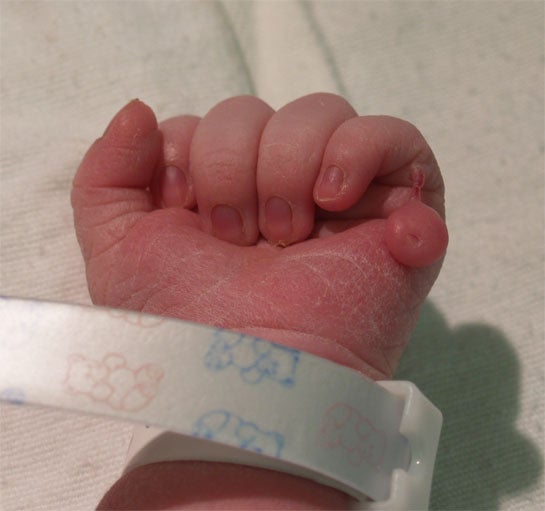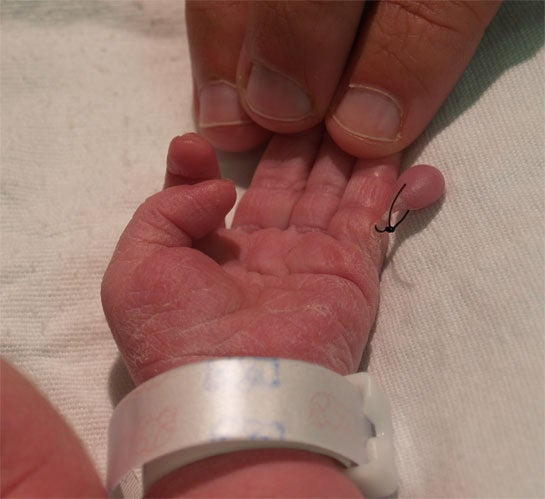EXTREMITIES
REFLEXES: ROOTING, SWALLOWING, MORO, TONIC NECK, PALMAR, PLANTAR, BABINSKI, STEPPING, GALANT
Extremities
Make a general check of the extremities. Note color, symmetrical, range of motion and flexion of legs and arms.
- Count toes and fingers and note absence, excess or webbing of fingers or toes.
|
|
|
|
Polydactyly |
Ligation of extra digit which falls off |
Pictures used with permission Dr. Janelle Aby, Stanford Medical School, Palo Alto, CA
- Note acrocyanosis
 of feet or hands.
of feet or hands.
- Soles of the feet in term
 infants are well lined (or wrinkled) over two thirds of the foot.
infants are well lined (or wrinkled) over two thirds of the foot. - Note the palmar creases. The infant should have two palmar creases which go across the palm of the hand. If only one is found, the physician should be informed.
- Check the infant for flexion of both arms and legs. An infant who is floppy and does not hold extremities close to the body may hypotonia and need additional assessment by the physician. This infant may also have difficulty feeding due to weakenned rooting and suck reflexes. A term infant should be able to hold its head up for a short period of time.
- Check the hips for dislocation. Use the Ortolani and Barlow's method to assess. The newborn video has a very good demonstration of how this is done.
Reflexes
Assessment of the reflexes determines the maturity of the neurological system. See your maternity textbook, Lowdermilk & Perry (2007), p. 653-655. Many of these reflexes are no longer evident by 4 to 6 months of age. The reflexes include the palmar grasp, sucking, rooting, swallowing, tonic neck or "fencing", moro, stepping, crawling, babinski and plantar grasp. As you become more proficient in your exam you can incorporate these reflexes in other parts of your exam.
While assessing the arms, put a finger in each of the infant's palms. The infant's fingers will curl around yours. Show the parents about their amazing newborn at the same time you do the assessment of the palmar or grasp reflex.
The sucking and swallowing reflexes
and swallowing reflexes are present in the term infant. They may not be present in the preterm infant. Feeding by breast or bottle cannot be initiated until the suck and swallow reflexes are present in the preterm infant.
are present in the term infant. They may not be present in the preterm infant. Feeding by breast or bottle cannot be initiated until the suck and swallow reflexes are present in the preterm infant.
The rooting reflex is elicited by stroking the cheek, lip or corner of the mouth. The infant turns the head toward the stimulus and opens the mouth. If close to the breast, the infant takes the nipple and begins sucking. Watch the video on how to elicit the rooting reflex.
is elicited by stroking the cheek, lip or corner of the mouth. The infant turns the head toward the stimulus and opens the mouth. If close to the breast, the infant takes the nipple and begins sucking. Watch the video on how to elicit the rooting reflex.
Hold the infant in a semi-sitting position and allow the head and trunk to fall backward to an angle of at least 30 degrees. The arms will symmetrically abduct and extend while fanning the fingers to form a C with thumb and forefinger. Legs follow a similar pattern. A tremor may be seen. (The infant is not shivering). This is the moro reflex . While you have done other parts of the exam, you may have already noticed the infant throw his/her arms out in response to jarring the the bed or a loud laugh. This is sufficient to assess the reflex.
. While you have done other parts of the exam, you may have already noticed the infant throw his/her arms out in response to jarring the the bed or a loud laugh. This is sufficient to assess the reflex.
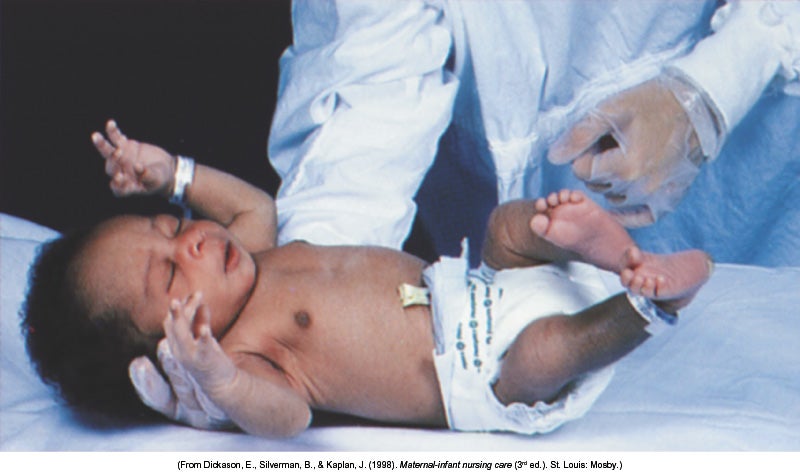
Moro Reflex (Elsevier)
Watch two videos on how parents have elicited the Moro Reflex:
The tonic neck or fencing reflex i s seen by turning the head gently to one side while the infant is falling asleep or sleeping. With the face looking to the left, the left arm and the left leg will be extended. The right arm and leg will be flexed. Turn the face to the right and the right leg and arm will be extended and the left arm and leg will be flexed. Watch the short video about what the tonic neck reflex looks like.
s seen by turning the head gently to one side while the infant is falling asleep or sleeping. With the face looking to the left, the left arm and the left leg will be extended. The right arm and leg will be flexed. Turn the face to the right and the right leg and arm will be extended and the left arm and leg will be flexed. Watch the short video about what the tonic neck reflex looks like.
The plantar reflex i s elicited by pressing your finger at the base of the toes. The toes curl around your fingers.
s elicited by pressing your finger at the base of the toes. The toes curl around your fingers.
Babinski reflex is elicited by moving your finger on the side of the foot from the heal across the the ball of the foot. A positive babinski is normal in newborns when all toes hyperextend with dorsiflexion of the big toe. Click here to view a babinski reflex.
is normal in newborns when all toes hyperextend with dorsiflexion of the big toe. Click here to view a babinski reflex.
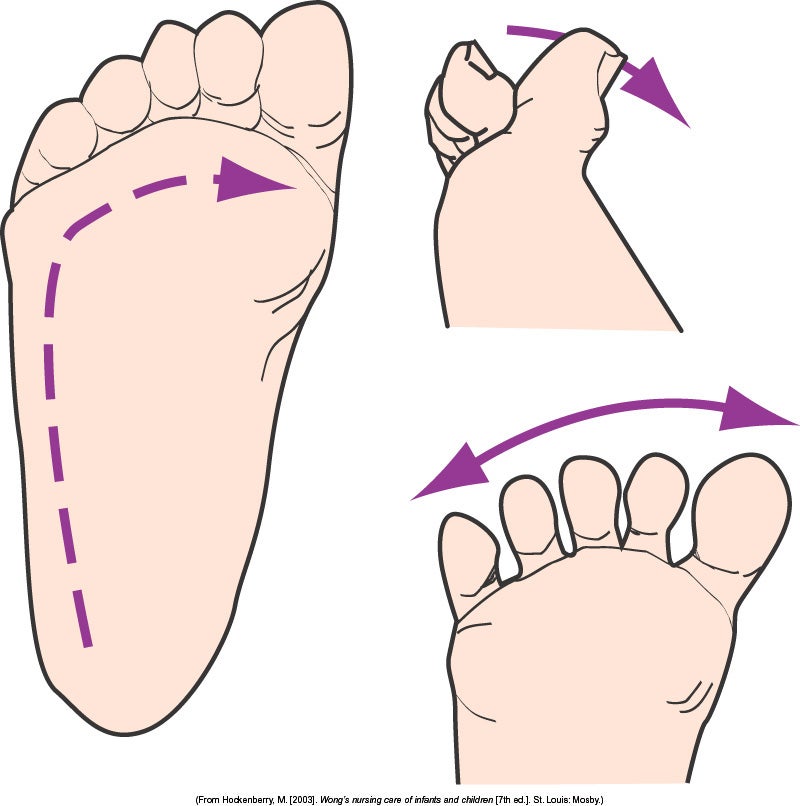
Babinski Reflex (Elsevier)
The stepping reflex can be elicited by holding the infant vertically, allowing one foot to touch the table and then the other. Click here to view a video of the stepping reflex.
can be elicited by holding the infant vertically, allowing one foot to touch the table and then the other. Click here to view a video of the stepping reflex.
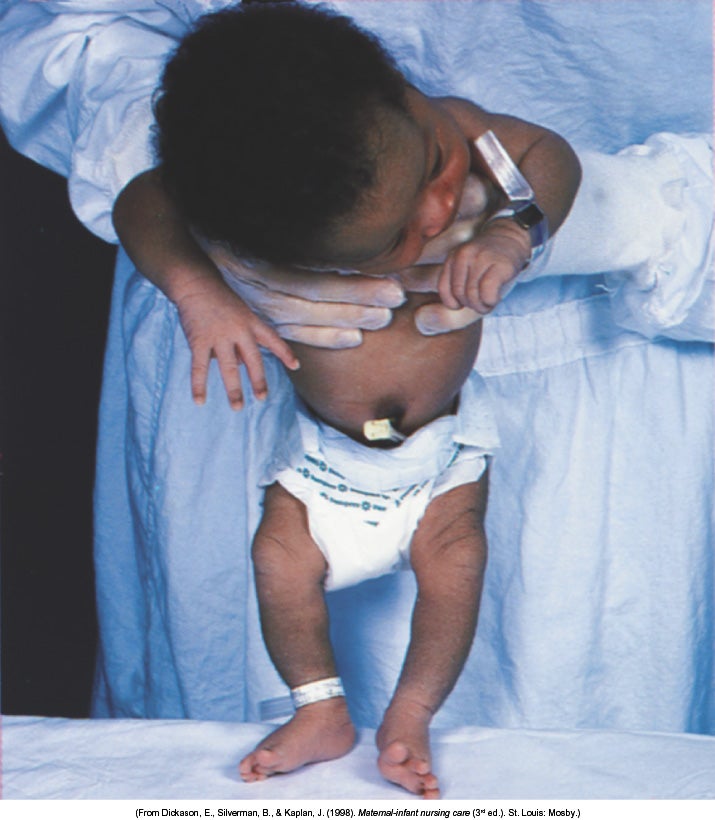
Stepping Reflex (Elsevier)
Galant or trunk incurvation is seen when the infant is placed prone. Run the finger down the back lateral to the spine. The trunk will swing toward the stimulted side. Watch the movie to learn how to elicit the Galant reflex.
is seen when the infant is placed prone. Run the finger down the back lateral to the spine. The trunk will swing toward the stimulted side. Watch the movie to learn how to elicit the Galant reflex.
For additional video clips of the reflexes please click here.
